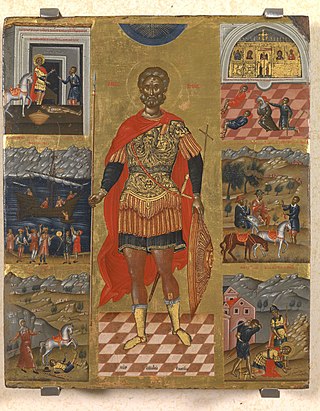
Cretan School describes an important school of icon painting, under the umbrella of post-Byzantine art, which flourished while Crete was under Venetian rule during the late Middle Ages, reaching its climax after the Fall of Constantinople, becoming the central force in Greek painting during the 15th, 16th and 17th centuries. The Cretan artists developed a particular style of painting under the influence of both Eastern and Western artistic traditions and movements; the most famous product of the school, El Greco, was the most successful of the many artists who tried to build a career in Western Europe, and also the one who left the Byzantine style farthest behind him in his later career.

Angelos Akotantos was a Greek painter, educator, and protopsaltis. He painted icons in the maniera greca, at a time when that style was moving away from the traditions of the Byzantine Empire and towards the more refined aesthetic of the Cretan School. Akotantos taught painting to Andreas Pavias, Andreas Ritzos, and Antonios Papadopoulos, and his style influenced later artists such as Georgios Klontzas, Theophanes the Cretan, Michael Damaskinos and El Greco. Angelos's brother Ioannis was also a famous painter. There are 50 extant paintings reliably attributed to Akotantos, 30 of which bear his signature.

Andreas Ritzos also known as (Rico, Ricio, Rizo). He was a Greek icon painter, from Crete. Ritzos is considered one of the founding fathers of the Cretan School. He was affiliated with Angelos Akotantos. Most of his work stylistically follows the traditional maniera greca. His children, grandchildren, and great-grandchildren were also painters. He was one of the most influential painters of the Cretan School along with Andreas Pavias and Angelos Akotantos. He influenced the works of Georgios Klontzas, Nikolaos Tzafouris, Theophanes the Cretan, Michael Damaskinos and El Greco. According to the Institute for Neohellenic Research, sixty of his paintings have survived.

Nikolaos Tzafouris(Greek: Νικόλαος Ζαφούρης η Τζαφούρης) 1468-1501), also Niccolo, Niccolò, Niccolö, Zafuri, Zafuris, was a Greek Renaissance painter. He was one of the founders of the Cretan School. He was influenced by Angelos Akotantos. His works influenced Emmanuel Tzanes, Elias Moskos, Georgios Klontzas and Theodoros Poulakis. Tzafouris was one of the most respected artists in Crete. His most notable work is Madre della Consolazione. The painting exhibits a combination of Byzantine and Italian styles. Another notable painter in Crete around the same time was Andreas Pavias. According to the Institute of Neohellenic Research, thirteen paintings are attributed to Tzafouris.

The Crucifixion is a tempera painting by Andreas Pavias, who was active in Crete during the second half of the 15th century and is considered part of the Cretan School. It is now in the National Gallery of Greece. The painting influenced countless arts. Georgios Klontzas, Emmanuel Lambardos, Ioannis Moskos created similar works. Pavias introduced multiple figures to his Crucifixion. Georgios Klontzas began to employ a similar method in his famous work In Thee Rejoiceth. A work that was emulated by Theodore Poulakis and Franghias Kavertzas. The painting exhibited characteristics of the traditional maniera greca and the Venetian style.

Ilias or Elias Moskos was a Greek educator, shipping merchant and painter from Crete. The last name Moskos was associated with three famous painters of the Cretan School alive during the same period, along with Ioannis Moskos and Leos Moskos, possibly his relatives. Elias incorporated maniera greca with the Venetian style. Theodore Poulakis and Moskos brought the art and style of Crete into the Heptanese School of the Ionian Islands. Some of his work was inspired by Angelos Akotantos. He was affiliated with other artists such as Philotheos Skoufos. He is often confused with Leos Moskos. His son was not Ioannis Moskos although they were probably related. Elias most popular painting is Christ Pantocrator. Fifty-two of his paintings survived.

Ιoannis Apakas, also known as Johann Apakass was a Greek painter and priest. He was active in the latter part of the 16th century to the early 17th century. He was popular artist during his time.

Leo or Leos Moskos was a painter and educator. There were two other painters named Moskos active around the same period, Elias Moskos and Ioannis Moskos, who may have been his relatives. Indeed, Leo is often confused with Elias Moskos. Some of his work was inspired by Georgios Klontzas and Franghias Kavertzas. He traveled all over the Venetian Empire. Records indicate he traveled to Venice, Cephalonia, and Zakynthos His style resembled the Cretan School. He taught famous painter Panagiotis Doxaras. His most popular work is the Last Judgment. His paintings can be found all over the world. Twenty of his paintings have survived.
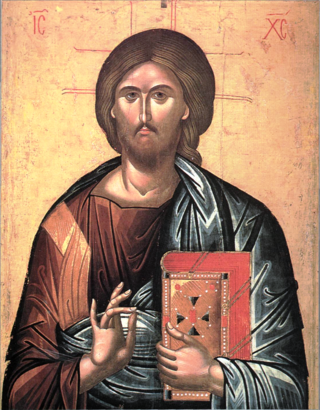
Euphrosynos was a Greek Renaissance painter. He was a priest and influenced by Byzantine art and the early Cretan School. Five of his works have survived, all of them are in Greece. His technique resembled the works of Andreas Pavias, Angelos Akotantos, and Andreas Ritzos. Euphrosynos may have been a member of the prominent Klontzas family. His paintings of the Virgin Mary and Jesus are typical Cretan School paintings. His Jesus painting resembles Pavias's painting Christ Pantocrator. All of his works are at Mount Athos in the Dionysiou Monastery. They decorate the iconostasis. Fragkos Katelanos and Theophanes the Cretan were also working at Mount Athos around the same period.
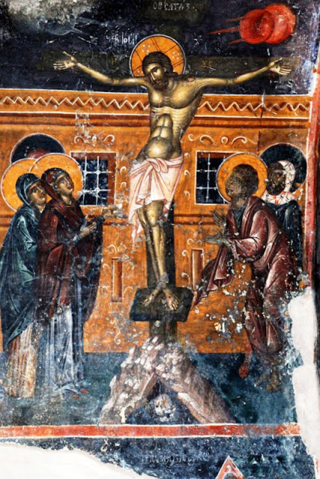
Manuel Fokas, also known as Manuele Fuca. He was a Greek Byzantine painter. He was a member of an important Greek Byzantine family. His family consisted of many painters in Crete. They flourished during the 15th and 16th century. Most of his frescos have survived until today. Other Greek-Byzantine painters included: Georgios Kalliergis, Ioannis Pagomenos, and Theodore Apsevdis. Another very important painter active around the same period in Crete was Nikolaos Philanthropinos. Three churches in Crete containing Fokas's frescos are Saint George, Emparaso, Agios Konstantinos Avdou, and Saint George Apano Symi. He influenced countless artists both Greek and Italian. Notable artists from Heraklion that his work influenced include: El Greco, Georgios Klontzas and Michael Damaskinos.

Saint Anne with the Virgin is a tempera painting attributed to the Greek painter Angelos Akotantos. Angelos Akotantos is one of the founding members of the Cretan School along with Andreas Ritzos, Andreas Pavias, and Nikolaos Tzafouris. Angelos Akotantos was active during the first half of the 15th century. According to the Institute of Neohellenic Research, fifty paintings are attributed to Angelos Akotantos.

The Last Judgment also known as The Second Coming is an egg tempera painting by Francheskos Kavertzas. His artistic period was during the first part of the 17th century. Seven of his works survived, five were signed. He was a member of the late Cretan School. The Last Judgment painted by Georgios Klontzas inspired countless Cretan artists, Kavertzas was one of them. Kavertzas's painting In You Rejoiceth strongly resembles Klontzas's In Thee Rejoiceth. Leos Moskos was also inspired by Klontzas's work. He also painted a similar version of The Last Judgment. The final judgment is the last judgment of every person on earth. The painting is a pictural representation of that event. The Kavertzas The Last Judgment is unique because it features a nun. Her name was Evgenia Trapezontiopoulla. According to records on March 9, 1641, the nun could not afford to pay for the painting. Kavertzas and the nun bartered instead. The painting is part of the collection of the Hellenic Institute of Venice in Italy.
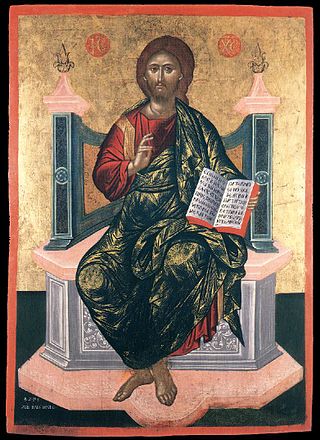
Christ Enthroned was a tempera painting created by Elias Moskos. Moskos was a representative of the Late Cretan School. The artist was also associated with the Heptanese School due to his migration to Zakinthos and the transition of his painting style. Moskos also taught painting. Most of his students became church committee members. Church committees were responsible for commissioning paintings. He was active from 1645 to 1687 on the islands of Crete, Zakynthos, and Kefalonia. Fifty-two of his works survived, over half of them were signed. Two other painters named Moskos were active during the same period Ioannis Moskos and Leos Moskos.

Christ the Vine is an egg tempera painting by Victor. Victor was a Cretan painter active during the 17th century. The painter traveled all over the Venetian empire. He eventually settled in Zakinthos. He is one of the most important painters of the 17th century due to the enormous amount of his existing works. His catalog of art exceeds over ninety-five paintings.

Christ Enthroned is a tempera icon by Emmanuel Tzanes, a Greek painter of the Late Cretan School. It is currently at the Byzantine & Christian Museum in Athens.
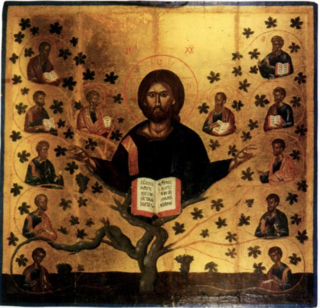
Christ the Vine is a tempera painting created by Greek painter Angelos. Angelos was active from 1425 to 1457. He was a teacher and protopsaltis. His students included some of the most famous painters of the early Cretan Renaissance. Andreas Pavias and Andreas Ritzos were his students and were heavily influenced by his style. Forty-nine of his works survived. Angelo’s Christ the Vine was one of his most important works.
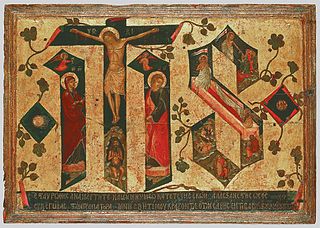
Jesus Hominum Salvator is a tempera painting by Andreas Ritzos. Ritzos was one of the founders of the Cretan School of painting. His teacher was Angelos Akotantos. Andreas Ritzos was active from 1436 to 1492. He painted in the traditional Greek-Italian Byzantine style combined with Italian Renaissance Venetian painting. The technique later became known as the maniera greca. Sixty of his works survived.
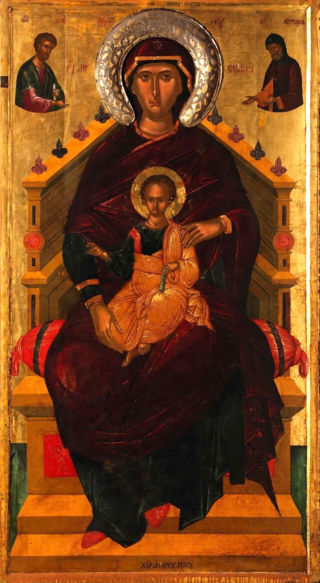
The Virgin Pantanassa is a tempera painting by Andreas Ritzos. Ritzos was a Greek painter active on the island of Crete. He flourished from 1435 to 1492. The painter has an existing catalog of over sixty works attributed to him. He signed his works in both Greek and Latin. He is one of the most influential painters of the Cretan Renaissance. He painted in the traditional Greek-Italian Byzantine style. His work was also heavily influenced by Venetian painting. His teacher was Angelos Akotantos. He was also affiliated with Andreas Pavias. His son was famous Greek painter Nikolaos Ritzos. Ritzo's Italian contemporaries were Paolo Uccello and Fra Angelico. They all painted a mixture of the Greek-Italian Byzantine and Italian Renaissance styles. The art of Crete was heavily influenced by the founder of the Venetian school Paolo Veneziano.
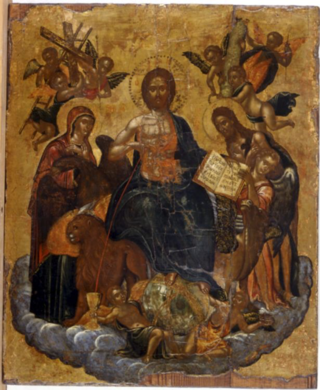
Tribute to the Eucharist was a painting made of egg tempera and gold leaf on a wood panel. The portable icon is attributed to Greek painter Michael Damaskinos. Damaskino's existing catalog features over 100 known works. He was a member of the Cretan school of painting. He was from the island of Crete. His contemporaries were Georgios Klontzas and El Greco. Damaskinos traveled all over Italy for over twenty years. He spent a significant amount of time in Venice. He adopted Italian mannerisms. He applied these new attributes to his paintings. He was friends with sculptor Alessandro Vittoria. He had a collection of drawings obtained from other Italian artists. Namely the Mannerist Parmigianino. He was also exposed to the magnificent works of Italian painter Raphael.

The Dormition and Assumption of the Virgin is a tempera painting created by Elias Moskos. Moskos was a representative of the Late Cretan School and the Heptanese School. He migrated to Zakinthos from Crete. He was originally from the city of Rethymno. He participated in the transition of Greek painting from the Cretan School to the more refined Heptanese School of the Ionian islands. He also taught painting. His activity was from 1645 to 1687. He was active on the islands of Crete, Zakynthos, and Kefalonia. He was heavily involved with church committees. Church committees commissioned paintings. Half of his works were signed fifty-two of his works survived.




















